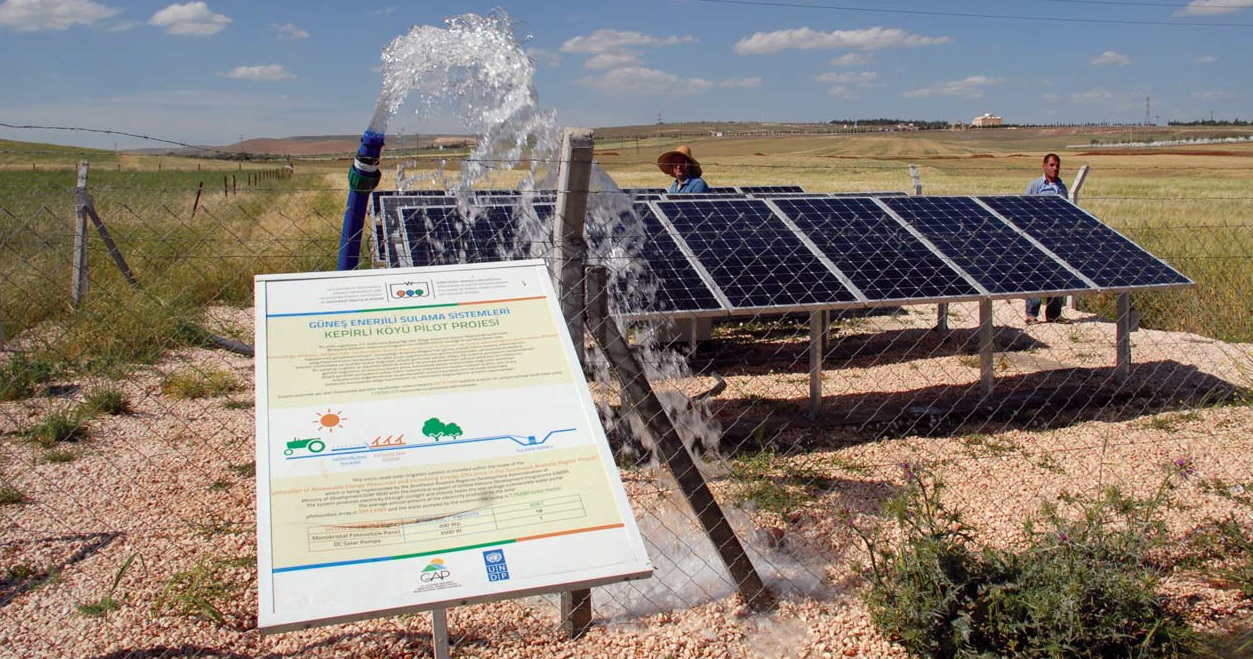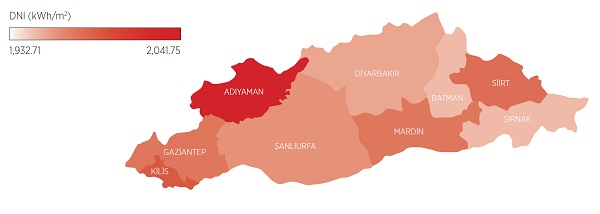Utilization of Renewable Energy (RE) Resources and Increasing Energy Efficiency (EE) in the Southeast Anatolia Region Project (the Project) is being implemented by the Southeast Anatolia Regional Development Administration of Turkish Ministry of Development (GAP RDA), with the technical support of the United Nations Development Programme (UNDP). In line with the main vision of the Competitiveness Agenda in 2007 for Southeastern Anatolia Region, the Project aims at developing in sustainable and socially equitable way, and contributing through energy efficiency practices and more widespread use of renewable energy.
RE and EE projects aim at not only testing the technical and implementation in this Region, but also with an integrated approach creating an increasing effect on industry, service, tourism, agriculture fields with additional values such as competitiveness, employment, trained labor, increasing research capacity. With the increase of primary energy supply in Turkey, there is no an improvement observed for the supply of consumption with the production.

The production and consumption ratio is 28,0% in 2008 and is 29,5% in 2009, moreover it is observed that in 2010 the ratio remained at a similar level. These data showed that in Turkey’s primary energy supply, the external dependency is at a level of approximately 70%. The same applies for the production of electricity, more than half of the electricity produced in Turkey are provided from the imports of primary energy sources (mostly natural gas).
On the other hand, 170 million tonnes of CO2 equivalent greenhouse gas emissions in 1990 increased to 372 million tonnes of CO2 equivalent in 2007 in Turkey. Emissions from electricity generation play an important role in this increase, during the same period, with the increase of emissions from 30 to 233%, it reached 100 million tonnes of CO2 equivalent. So, while the share of total emissions of greenhouse gas emissions originating from electricity generation is at the level of 17% in 1990, in 2007 it has reached at the level of %27. Either to reduce the dependence on foreign energy supply, or to be kept at a reasonable level of carbon emissions due to electricity production, it is necessary to evaluate fully the highest proportion of renewable energy sources is an indigenous resource.
Electricity generation from renewable energy sources in Turkey is carried out largely from hydraulic resources. However, “Law on Utilization of Renewable Energy Sources”, the law no. 5346, which came into force in 2005, a legal framework for the evaluation of hydraulic resources, as well as other renewable energy sources were established. With this legal framework; some price incentives and investment facilities such as solar, wind, geothermal, biomass, to be shareholders of other renewable energy sources in electricity production were achieved.
In recent years, the production of electricity from renewable energy sources, including wind and hydro energy in particular has been growing rapidly in Turkey. Southeastern Anatolia Region, with its rich water and sun as the source for renewable energy has great potential. From dams 15.7 billion kWh of electricity of the region was produced in 2008, this figure corresponds to approximately 8% of Turkey’s consumption in 2008.
The total installed capacity of power projects which has not yet completed in the region is 1,972 MW and it corresponds to approximately one quarter of the total power projected for the region.
With all of these, the region will become a hydroelectric paradise. Situated in a Region called “sunbelt” in Turkey, the use of solar energy potential is very high and this potential has reached the highest values in both the Mediterranean and Southeastern Anatolia Regions. With regards to generating electricity from solar energy, Southeastern Anatolia Region is much more convenient than the Mediterranean Region where tourism and agriculture have developed so much and because of these this region also has very high land prices.

Province-Based Direct Normal Irradiance (DNI) Values in Southeastern Anatolia Region
Southeastern Anatolia Region is rich in agricultural waste. In Turkey’s total cotton production, there are 50% share in the region. Therefore, it is estimated that the amount of agricultural waste of cotton and other products is suitable for building a power plant with a few hundred MW. On the other hand, due to the presence of animals, animal waste also has the potential to be added to the energy portfolio in this region. Evaluation of opportunities for the region’s gas and electricity production from agricultural and animal waste will ensure the diversification of renewable energy sources and will enable the emergence of the domestic manufacturing sector. On the other hand, although not as much as in the Aegean and Marmara Regions, the fact that cannot be neglected is that a wind potential is available in the region. Wind speed and density in the region is not as good as in the western part of Turkey and some promising places exist in terms of wind energy potential in Gaziantep, Kilis and Mardin. More importantly, it can be possible to use small and medium-scale wind turbines in combination with solar energy to supply local needs (water pumping and irrigating operations, etc.) in some regions where low-speed winds can be found.
It requires extensive and encompassing approach to activate potential that the dimensions of it is briefly explained, and to deliver the electricity that is produced safely. When taking into consideration of the liberalization of the electricity market, new electricity generation investments, to be carried out by private companies, continuation the process of privatization of electricity distribution companies, there is a need for an integrated strategy for the implementation of renewable energy investments and for the region to become a focus of attention and attraction for investors. On the other hand, the awareness of using energy efficiently is low in this region like in Turkey’s general regions. Due to the traditional production trends and hot climate in the industry, the buildings where there is no insulation and the uncollected energy consumption causes inefficient energy consumption in the region and therefore it leads to higher energy density. The energy density is an index expressing the total energy required to produce a unit of value added and when energy density decreases, the same amount of value added, less energy and thus can be manufactured less costly. Applying for energy efficiency measures has a great importance in areas where there is energy consumption to reduce energy intensity, but especially in industrial plants and buildings. The limited part of the energy efficiency measures to be taken in the industrial sector requires changes of processes and it requires relatively large investments. On the other hand, the majority of these measures could be implemented at low cost investment that will not affect the main investment strategy of the company.
The inefficient use of energy in both residential buildings as well as commercial purposes and existence of many of the buildings without insulation, large size of the energy spent for cooling the energy needed for heating were observed. With the light of this data, the execution of various applications to improve the energy efficiency of buildings is considered as necessary. Spreading investments in improving the building towards commercial and residential buildings starting from public buildings is a primary requirement of public sector. It is important to raise awareness not only about improving insulation in the buildings, but also about the electrical appliances for the regional consumers who have difficulties to pay the electricity bill.
The principles of taking sustainable development approach envisaged for the region as a basis were adopted in promoting the use of both renewable energy sources in electricity and heat production in this project and action plan and in the realization of works and actions aimed at improving energy efficiency. In this context, increasing employment, education of the population participating in the labour force, the development of industry competitiveness, branding in unique products and services, issues such as the mobilization of civil society have been issues that are taken into consideration in the project. In addition, subjects have been evaluated as well as the horizontal axis and according to sectors.
In the industrial sector, it was focused on the options mentioned about the manufacture of some products in the region under the project and in this context, the search for new cooperation and incentives have become a current issue. Due to the fact that many components of the solar thermal product range are manufactured with manufacturing techniques that require low technology, it has been evaluated that finding a proper environment to produce products with low cost and quickly in region. In addition, to have a higher proportion of sun geography in the south of the region indicates the richness of the potential market for the products to be produced. From the data that offers a great potential for direct thermal and electrical industry applications of solar energy to mobilize this potential, the project proposals to be implemented regarding use of this potential have been always welcome.
Both with the food security aspect, and with potential employment opportunities, the agricultural sector in the region came into force as a strategic sector and bumper. In the Region where there are a very high possibility of renewable energy and also where intensive agriculture-husbandry activities are carried out, dealing with agriculture and renewable energy will affect the development of both field and the increase of employment positively. With regards to the preservation of ecological balance and the balanced use of natural resources, in transition to sustainable production the rehabilitation of irrigation practices and the dissemination of solar-assisted irrigation pumps will be critical steps. However, the evaluation of rich agricultural and animal waste in the Region will provide the development of biomass and biogas applications.
As mentioned above, sustainable growth approach has been adopted as the basic principle inactivity to be carried out and in results of the Project. The studies identifying areas of potential progress in the field of renewable energy and energy efficiency in the region under the first phase of the project were identified with a strategy and action plan in July 2009 -May 2011 period. In line with the foresight of this action plan, the second phase of the project is planned to give more weight to the activities of the application. Three basic components of the second phase of the project;
• Determination of opportunities of EV / YE and conducting best practices and disseminating in South-eastern Anatolia Region, industries and services in the building (Output 1);
• Increasing the usage of YE potential of South-eastern Anatolia (Output 2) and
• Technical, institutional and capacity development of labour with respect of EV and YE, in industry, services, construction and agriculture sectors in the region (Output 3)
On 16 February 2012, Republic of Turkey Ministry of Development GAP Regional Development Administration, Republic of Turkey the Ministry of Foreign Affairs and the United Nations Development Programme by the project’s second phase following the signing of the project document by the parties concerning Renewable Energy and Energy Efficiency Project in the region started the second phase.
